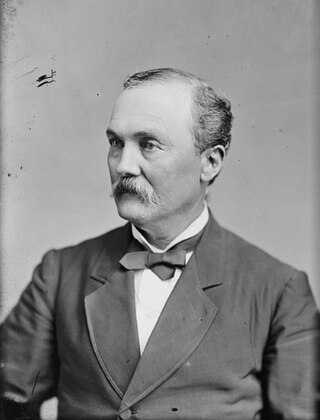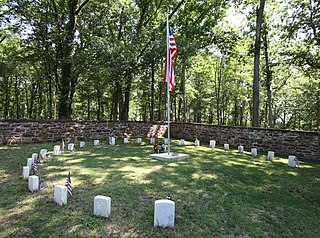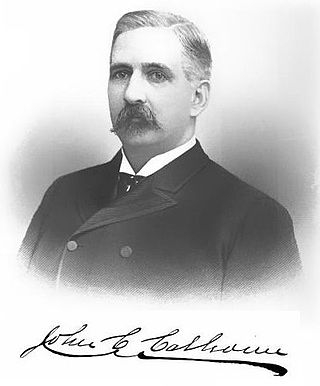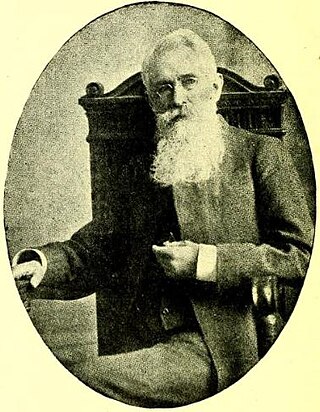
Webster County is a county located in center of the U.S. state of Mississippi, bordered on the south by the Big Black River. As of the 2020 census, the population was 9,926.

John Jones Pettus was an American politician, lawyer, and slave owner who served as the 23rd Governor of Mississippi, from 1859 to 1863. Before being elected in his own right to full gubernatorial terms in 1859 and 1861, he served as acting governor from January 5 to 10, 1854, following the resignation of Henry S. Foote. A member of the Democratic Party, Pettus had previously been a Mississippi state representative, a member and president of the Mississippi State Senate. He strongly supported Mississippi's secession from the United States in 1861 and sought cooperation with the Confederate States of America.

The Battle of Ball's Bluff was an early battle of the American Civil War fought in Loudoun County, Virginia, on October 21, 1861, in which Union Army forces under Major General George B. McClellan suffered a humiliating defeat.

The Battle of Dranesville was a small battle during the American Civil War that took place between Confederate forces under Brigadier General J. E. B. Stuart and Union forces under Brigadier General Edward O. C. Ord on December 20, 1861, in Fairfax County, Virginia, as part of Major General George B. McClellan's operations in northern Virginia. The two forces on similar winter time patrols encountered and engaged one another in the crossroads village of Dranesville. The battle resulted in a Union victory.

Nathan George Evans was an American military officer who served in the United States Army before becoming a general in the Confederate States Army during the American Civil War.

Eppa Hunton II was a Virginia lawyer and soldier who rose to become a brigadier general in the Confederate Army during the American Civil War. After the war, he served as a Democrat in both the United States House of Representatives and then the United States Senate from Virginia.

William Barksdale was an American lawyer, newspaper editor, U.S. Representative, and Confederate general in the American Civil War. He served four terms in the U.S. House of Representatives from 1853 to 1861.
Loudoun County, Virginia, was destined to be an area of significant military activity during the American Civil War. Located on Virginia's northern frontier, the Potomac River, Loudoun County became a borderland after Virginia's secession from the Union in early 1861. Loudoun County's numerous Potomac bridges, ferries and fords made it an ideal location for the Union and Confederate armies to cross into and out of Virginia. Likewise, the county's several gaps in the Blue Ridge Mountains that connected the Piedmont to the Shenandoah Valley and Winchester were of considerable strategic importance. The opposing armies would traverse the county several times throughout the war leading to several small battles, most notably the Battle of Ball's Bluff.
Robert Ludwell Yates Peyton was a Missouri attorney, politician and Confederate States Army officer who served as a Confederate States Senator from February 18, 1862, until his death in Alabama of malaria contracted while defending Vicksburg, Mississippi in 1863.

John Henry Caldwell was a U.S. Representative from Alabama.

Ball's Bluff Battlefield Regional Park and National Cemetery is a battlefield area and a United States National Cemetery, located 2 miles (3.2 km) northeast of Leesburg, Virginia. The cemetery is the third smallest national cemetery in the United States. Fifty-four Union Army dead from the Battle of Ball's Bluff are interred in 25 graves in the half-acre plot; the identity of all of the interred except for one, James Allen of the 15th Massachusetts, are unknown. Monuments to fallen Confederate Sergeant Clinton Hatcher and Union brigade commander Edward Dickinson Baker are located next to the cemetery, though neither is buried there. While the stone wall-enclosed cemetery itself is managed through the Culpeper National Cemetery and owned by the Department of Veterans Affairs, the balance of the 223-acre (0.90 km2) park is managed through the Northern Virginia Regional Park Authority.
Fort Evans is a Civil War-era rectangular earthen fort located in Leesburg, Virginia. It was the first of three forts constructed in 1861 to protect Leesburg from possible invasion after Virginia seceded from the Union.

John Horace Forney was a farmer, civil engineer, and major general in the Confederate States Army during the American Civil War. Being promoted to the rank of major general on October 27, 1862, Forney participated in the Battles of First Bull Run and Vicksburg before being captured. He held several other commands until the end of the Civil War, living in Alabama until his death in 1902.
Fort Beauregard was a Civil War-era rectangular earthen fort located on a 430 feet (130 m) promontory above Tuscarora Creek just southeast of Leesburg, Virginia. Built in the winter of 1861–1862 following the Battle of Ball's Bluff, it was one of three forts built by Confederates to defend Leesburg against possible invasion. Fort Beauregard commanded the southern eastern approaches to the town, including the Old Carolina Road and the Alexandria and Winchester Turnpike. The fort may have been only partially constructed, and was never occupied by Confederates in force before Leesburg was evacuated in the spring of 1862. The fort was occupied by Union forces for a brief period in the summer of 1862. The fort was subsequently destroyed, and the exact location remains unknown. The likely site currently sits in the privately owned "Beauregard Estates" neighborhood.
Glenfiddich House, also known as Harrison Hall, is a historic house in Leesburg, Virginia. The house was built in three sections, with the first section completed in 1780. When viewing the house from the street, the left wing of the residence is the original home. Between 1850 and 1860, the main block of the home was built for Henry and Jane Harrison, by the Norris Brothers of Leesburg, and is a good example of the Italianate style of home. The property still includes historic outbuildings: a log springhouse with V-notched corners, circa 1800, and a brick meat house, circa 1855.
James Harvey Carson was a brigadier general in the Virginia militia, who served along with the Confederate States Army in northwestern Virginia at various times during 1861 and early 1862 in the American Civil War. Carson's men were part of Stonewall Jackson's force that moved to take the town of Bath, later Berkeley Springs, now in West Virginia, on January 3, 1862.
Agency is a ghost town located in Oktibbeha County, Mississippi, United States.

John Caldwell Calhoun II (1843–1918) was an American planter and businessman. He was a large landowner in Chicot County, Arkansas, and a director of railroad companies. He was a prominent financier and developer of the "New South".

Hugh McQueen Street was an American businessman and Democratic Party politician. He served in the Mississippi House of Representatives from 1870 to 1880, 1890 to 1894, and from 1908 to 1912. He was its Speaker in four different stints.

The 18th Mississippi Infantry Regiment was a unit of the Confederate States Army that took part in many battles of the Eastern Theater of the American Civil War.














